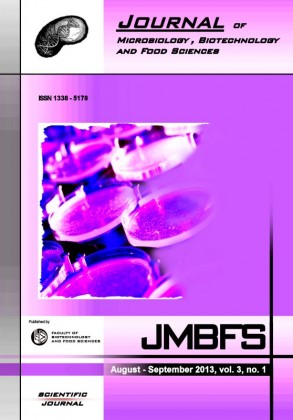PRODUCTION AND PARTIAL CHARACTERIZATION OF PECTINASES FROM MANGO PEELS BY Aspergillus tamarii
Keywords:
Pectinase, polygalacturonase, pectin lyase, solid state fermentation, mango peelsAbstract
Pectinases are a group of enzymes that are able to breakdown or transform pectin. Sources of pectinase comprise a wide variety of bacteria, yeast and filamentous fungi, especially Aspergillus sp. In this study pectinases (polygalacturonase and pectin lyase) were produced from mango peels by Aspergillus tamarii in solid state fermentation and a fraction of the crude enzyme solution obtained by ultracentrifugation was used for partial characterization assay. The maximum polygalacturonase production was 141.0095 U/g at day 3, 6 and 9 of incubation while the maximum pectin lyase production was 5670.50 U/g obtained at day 6. The optimum temperature and pH for polygalacturonase activity was between 40 – 70oC and 5.0 respectively while that of pectin lyase was 60oC and 7.5 respectively. The polygalacturonase produced was stable between pH 3.6 – 10.0 and at a temperature range of 30 – 70oC while the pectin lyase was stable between pH 7.0 – 8.5 and at 40oC. Na+, Mn+, Cu2+ and Zn2+ caused a significant increase in the activity of polygalacturonase whereas Fe2+ and Mg2+ caused a significant decrease in its activity (P≤0.05). The activity of pectin lyase was significantly increased by Fe2+, Mn+ and Zn2+ but significantly decreased by Cu2+, Mg2+ and Na+ (P≤0.05). Mango peel is a cheap, available and valuable substrate for pectinase production which could be useful for industrial applications especially in the food industry for processing fruit juices.Downloads
Download data is not yet available.
Downloads
Published
2013-08-01
How to Cite
Amande, T., Adebayo-Tayo, B., Ndubuisi-Nnaji, U., & Ado, B. (2013). PRODUCTION AND PARTIAL CHARACTERIZATION OF PECTINASES FROM MANGO PEELS BY Aspergillus tamarii. Journal of Microbiology, Biotechnology and Food Sciences, 3(1), 59–62. Retrieved from https://office2.jmbfs.org/index.php/JMBFS/article/view/7077
Issue
Section
Microbiology
License
Copyright (c) 2013 Tivkaa Amande, Bukola Adebayo-Tayo, Uduak Ndubuisi-Nnaji, Benjamin Ado

This work is licensed under a Creative Commons Attribution 4.0 International License.
All papers published in the Journal of Microbiology, Biotechnology and Food Sciences are published under a CC-BY licence (CC-BY 4.0). Published materials can be shared (copy and redistribute the material in any medium or format) and adapted (remix, transform, and build upon the material for any purpose, even commercially) with specifying the author(s).

